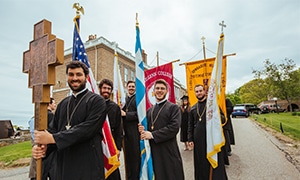HIS GRACE BISHOP JOACHIM OF AMISSOS PRESENTS PUBLIC LECTURE AT DUMBARTON OAKS

On September 23, His Grace Bishop Joachim of Amissos, Director of HCHC’s Archbishop Iakovos Library, presented a public lecture at Dumbarton Oaks, the Harvard Center for Byzantine Studies in Washington, DC, entitled “The Image of the Mother of God on Byzantine Lead Seals: Ubiquitous Presence/Rare Selection.” It was Dumbarton Oaks’ first in-person lecture since the beginning of the Covid-19 pandemic. His lecture was offered to coincide with the current Dumbarton Oaks museum’s special exhibition, Lasting Impressions: People, Power, Piety, curated by Jonathan Shea, Curator of Coins and Seals.
Of the many sacred figures depicted on Byzantine lead seals, that of the Mother of God is by far the most popular. Thousands of examples survive. Her ubiquitous sphragistic presence, continuous over many centuries, has provided a wealth of material for the fields of art history, history, religious studies, and sigillography, and as a means for studying the expressions of social and individual identity. In light of their chronological frequency, popular Marian iconographic types found on seals reflect broad and widespread visual cultural and devotional trends within Byzantine culture. At the same time, a rare sphragistic image of the Mother of God, with its accompanying inscription, can reveal much about the personal piety of the seal’s owner and the larger thought-world of the culture in which it was produced.
Before the evening lecture, Bishop Joachim was also invited to collaborate with the Curator of the Byzantine Collections and the Curator of Coins and Seals in leading the graduate student study day at which eight students were guided through the current special seal exhibition with an in-depth discussion of the displayed objects. An afternoon session followed in which the students dealt directly with objects of various media drawn from the Byzantine collection and a selected group of seals in order to demonstrate the connections of seal iconography and inscriptions within the broader context of Byzantine material culture.

 MyHCHC
MyHCHC



